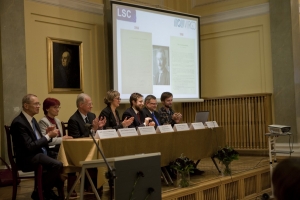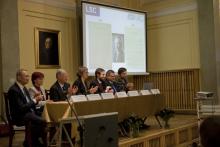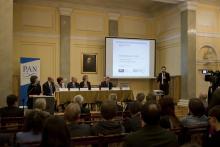
The discovery of gravitational waves was simultaneously announced on several press conferences held in various parts of the world, including Warsaw (photo Marianna Zadrożna)
Spacetime waves generated by collision of two black holes
Information supplied by Polish co-authors of the success
The LIGO (Laser Interferometer Gravitational-wave Observatory) collaboration has observed gravitational waves produced in effect of collision of two black holes. The observation has opened up new perspectives in research on the Universe.
For the first time in history scientists have observed some “wrinkles” on the spacetime “fabric”. These gravitational waves have arrived to Earth from a distant point in the Universe where some catastrophic event had taken place. The observation has confirmed one of the most profound consequences of the General Theory of Relativity proposed by Einstein in 1915 and has opened up quite new perspectives in research on the Universe.
Gravitational waves carry some otherwise unavailable information on their origin and on nature of gravitational forces. Physicists have concluded that the observed waves must have been created in a fraction of the last second before two black holes merged into a single larger spinning black hole. Such collisions were earlier theoretically predicted, but never observed.
Gravitational waves were registered on September 14, 2015 at 5.51 am EST i.e. at 9.51 am UTC by both LIGO detectors situated in Livingston (La) and Hanford (Wa). The observatories have been financed by NSF, organized by Caltech and MIT, and are run by the LIGO Scientific Collaboration (a joint venture of the GEO Collaboration, Australian Consortium for Interferometric Gravitational Astronomy, and the Virgo Collaboration). Gravitational waves have been detected in data acquired by both detectors. Paper with the results is to appear soon in Physical Review Letters.
More than 1,000 scientists and about 250 students from more than 90 universities/research institutions in the US and 14 other countries have teamed up into the LIGO Collaboration to improve the detectors and to analyse the acquired data. Two LIGO interferometers and the GEO600 detector are the basic equipment used by the LIGO Consortium.
Members of the GEO Collaboration include scientists from Max Planck Institute for Gravitational Physics (a.k.a. The Albert Einstein Institute), Leibniz University in Hannover (Germany), several British universities (Glasgow, Cardiff, Birmingham), and from University of the Balearic Islands (Spain).
The Virgo Collaboration consists of more than 250 physicists/engineers from 19 various research institutions in Europe, including 6 from CNRS (France), 8 from INFN (Italy), 2 from Nikhef (the Netherlands), the Wigner RCP group from Hungary, the POLGRAW group from Poland, and a group from European Gravitational Observatory (EGO) located close to Pisa (Italy). EGO is hosting the Virgo detector developed in line with a visionary idea proposed by Alain Brillet and Adalbert Giazotto. Application of some innovative technologies helped to extend detector sensitivity into the low frequency range. CNRS- and INFN-financed construction of the detector started in 1994. Since 2007 both Virgo and LIGO collaborations have jointly analysed data acquired by interferometers owned by the international research network. The Virgo detector was registering data until 2011 when the LIDO interferometers were modernized. The Advanced Virgo detector (financed by CNRS, INFN and Nikhef) is going to start operations before the end of this year. Many of the universities/research institutions from 5 European countries represented in the Virgo Collaboration have contributed both to the Advanced Virgo project, as well as to research efforts leading to discovery of gravitational waves.
Contribution of 15 Polish scientists teamed up in the POLGRAW group (a member of the Virgo Collaboration) to the first direct observation of gravitational waves produced in a binary black hole system is also significant. Professor Andrzej Królak (in cooperation with Professor Piotr Jaranowski) has laid the foundation and developed numerous methods to detect/estimate parameters of such waves. Professors Jaranowski and Królak contributed to precise modelling of such waves. Professors Krzysztof Belczynski and Tomasz Bulik have shown that binary black hole systems are the best systems from the point of view of detectability of gravitational waves by the LIGO-Virgo interferometers. Drs Michał Bejger, Izabela Kowalska-Leszczyńska, and Dorota Rosińska studied astrophysical properties of binary systems. Dr Adam Zadrożny looked for optical bursts possibly accompanying the collision events. Altogether 9 members of the POLGRAW group became co-authors of the paper in which discovery of gravitational waves was announced. Besides, several group members contributed other ways: Professor Królak served as a member of the Virgo Project Board of Directors and as a member of the LIGO-Virgo Consortium Data Analysis Committee; Professor Bulik served as a member of one of the LIGO-Virgo Consortium Work Overview Committees; Dr Michał Bejger participated in verifying software codes used to analyse the acquired data; Professor Królak was among internal reviewers of one of the papers presenting the discovery.Ten members of the Virgo-POLGRAW group: Paweł Ciecieląg, Magdalena Sieniawska, Orest Dorosh, Izabela Kowalska-Leszczyńska, Dorota Rosińska, Adam Zadrożny, Michał Bejger, Andrzej Królak, Piotr Jaranowski, Tomasz Bulik (photo Jakub Ostałowski)
The LIGO collaboration was proposed in 20th century decade of 80’ by three retired professors of physics: Rainer Weiss from MIT, Kip Thorne from Caltech, and Ronald Drever from Caltech.
Discovery of gravitational waves, an event of a major importance for science, was made already during the first run of the Advanced LIGO modernised version of the equipment. That version includes some instruments of a much improved sensitivity and capable to observe much larger areas of the skies than the first generation detectors. The Advanced LIGO equipment is sponsored first of all by US National Science Foundation, but significant contributions came also from German Max Planck Society, British Science & Technology Facilities Council, and Australian Research Council. Numerous technical solutions that were keys to increase sensitivity of the Advanced LIGO detector have been developed by the predominantly British-German GEO collaboration. Most of the IT infrastructure indispensable to analyse the acquired data was provided by AEI Hannover Atlas Cluster, the LIGO Lab, University in Syracuse, University in Wisconsin-Milwaukee. Other universities that participated in designing, constructing and testing of key elements of the Advanced LIGO equipment include: Australian National University, University in Adelaide, Florida University, Stanford University, Columbia University in New York, State University in Louisiana.








